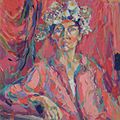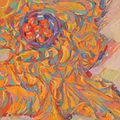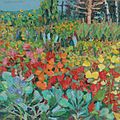Theodor Gerkens
Theodor Gerkens (born November 25, 1924 in Hamburg ; † August 21, 2013 in the Duchy of Lauenburg district ) was a German painter and graphic artist . He created egg tempera pictures , watercolors , woodcuts and drawings.
Life and artistic career
Theodor Gerkens was born in Hamburg-Großborstel. He tried portraying himself at school. After attending grammar school in Breitenfelder Strasse in Hamburg, he left his parents' house at the age of 15, where there was little understanding for the lively boy who was hungry for education. He lived in the spiritually stimulating house of his friend's mother. During this time he made his first serious attempts at painting, and for the first time he thought of making painting his profession.
His entry into the military put an end to normal developments in 1943 and the cruel experience of the war fell upon him. “Unpleasant, how generally valid, according to the year” as Theodor Gerkens later said. After his release from captivity at the end of 1947, he studied painting and graphics with Willi Titze (1914–1956) at the State Art School in Hamburg until 1951 . After that he was and remained a freelance painter and graphic artist. Then he joined the professional association for "fine arts" in Hamburg and later also in Schleswig-Holstein. He married and his son Jörg was born.
At the beginning of his life as a painter he dealt with different directions of abstract painting in his pictures. The rooster , which depicts a painterly coping with war and destruction, and the dream-lost seascapes, remain impressive to this day . The current absolute preference for non-representational painting at the state art school had irritated him and was contrary to his personal conception of painting. He did not want to deny the object, but to transform it into painting, play around with timbres and make the viewer feel the transformation process. Errors and clarifications. Again and again, however, the subjective recognition of the parallelism of all art expressions, between music and painting to a particularly high degree. A first exhibition in 1960 in the “Insel” gallery in Hamburg-Harvestehude was an attempt to mark the new path taken. In the sixties he received several state contracts from the Hamburg cultural authority for “art in architecture” (stele at the Finkenwerder pumping station , ceramics, tile mosaics, tapestry). During this time his data was also entered in the "Rump", the lexicon about Hamburg's visual artists. Around 1963 and in the eighties he worked on the large woodblock print, which he cut very freely and loosely, almost painterly.
A new order in his life in 1963, the cohabitation and later marriage with "Ra", enabled him to start again for the continuous realization of his idea of painting. In 1965 they both bought a small, derelict house, right on the canal. The renovation work was arduous as the house had neither electricity nor running water. It became a piece of jewelry. The self-created ambience of this simple house in solitude reveals an individual, artistic and spiritual attitude. The artist himself laid out and designed the large painter's garden.
In 1972 after the renovation of the house, the studio was ready and now the painter could begin to realize his ideas about his painting. From then on he painted intensely in front of nature until the end of 2009. His health was unstable. In 2010 he wrote the previously unpublished autobiography “Memories of the time lived and thoughts about my existence”. Then the old work was created in the studio.
painting
Theodor Gerkens preferred the technique of unpainted egg tempera . In tireless exercises, right in front of nature, he gradually mastered this old painting technique masterfully. A great sense of color, a spontaneous, emotional painting style full of verve and joy of color characterize his colorful and life-affirming pictures. Theodor Gerkens was a painter who tirelessly studied the color tones, the color harmonies, the color melodies and their psychological expressiveness and brought them to mastery in numerous pictures. He called his pictures, when they seemed successful, "emotion stenograms". Theodor Gerkens called the emotion stenogram the painter's rising emotion in front of what was seen, captivating in the picture in color sound units, making the unfolded feelings perceptible and decipherable through color codes. He drew his painterly inspiration from the life that surrounded him. This was mainly the self-designed painter's garden with its abundance of flowers, but also the meadow landscape with the large cloudy sky, trees and tree trunks, portraits, varied still lifes , integrated still lifes, studio still lifes with interior and much more. They are pictures that are dedicated to pure painting. You renounce the literary content. To praise the beauty of creation with his pictures was a deep concern of the painter. He remained creative well into old age and painted the imaginative "old work".
Series
The painter liked to use the series, in which each work stimulates the next exercise and a whole suite emerges from it, which intensifies in contrasting colors. "The spirit of the series inspires the imagination and one is amazed and amazed at the picturesque and tonal journeys to which the rooms can be filled with many variations and color-tonal contrasts and constantly develop new expressive powers"
Development of color tones
His idea of the color sounds was stimulated by the music. “I was obsessed with making the color tones more and more intense. I was deeply impressed by the baroque trumpets, where the bright fortissimo tones produce the most wonderful harmonic timbres and no matter how great they have climbed. So I wished for a similar ability, in which pure high-tone colors unite to create such magical timbres, to a color harmony in which the color and nothing but the color is the dominant element in the picture, without the natural appearances of the To do a cake to earth. "
plant
Still life
The still lifes, which are constantly being rediscovered and invented in color, occupy a considerable place in the painter's oeuvre. In the most diverse timbres and color harmonies, depending on the inspiration, there is variation after variation in imaginative diversity. Integrated still life : the integration of the actual still life motif into a colored world of sound, the only structural aid of which consisted of a folded cloth as a basis, could be varied in color in an infinite variety. With that he had found a completely independent form that allowed him to play colorful music freely and uninhibited.
Portraits
"And yet the face is a landscape refined in many subtle details, in which one tries to empathize in order to make something sensible that is otherwise not recognizable in the banal similarity"
Trees and logs
“Whether in front of the portrait, in front of nature, in front of its flowers, in front of the trees, in front of the landscape, it is not enough to look at them intensely, but one has to empathize with them, make their essence their own, try to understand them, to understand which characteristics control their appearance and force them to change. In this way I look at the trees, their distinctive trunks, and treat them painterly like portraits. So every tree trunk I portray gets its specific physiognomy belonging to it "
The garden and the flowers
“With its excitingly beautiful vegetation, the garden demanded its picturesque tribute, which I made a self-evident permanent task to afford and which ultimately dominated my mind in its overwhelming beauty. Here the whole spectrum of colored emotions spread out, stimulating a color orchestra with constantly changing, stimulating impulses, which ignited emotions with irresistible force that constantly developed organically into new colored combinations. I did not deny the omnipotence of nature, I was fervently incited to become a panegyric of the beauty of creation and to this day I am committed to this magical invitation. "
Retirement work
Very poor health forced the painter to creatively redesign his painting. In the last three years of his life, painting was only possible in the studio. He drew the necessary inspiration from his treasure trove of black-and-white drawings, pastels, oil pastels, older studies and bouquets of flowers. In his tree pictures he emphasized the graphic element, in his flower still lifes the geometric element, in his meadow and cloud pictures the contrast and also the harmony between heaven and earth. On the now preferred small format, he simplified the structures and chose luminous and radiant color tones.
Exhibitions
| 1960 | First exhibition in the "Insel" gallery, Hamburg, Harvestehude |
| 1977 | Two exhibitions with Lutz and Reinhard Böhme, Publik Relation |
| 1979 | Exhibition in the Lohgerberhaus, Mölln |
| 1980 | Exhibition in the Oberpostdirektion, Hamburg |
| 1985 | Exhibition in the Dresdner Bank, Hamburg |
| Exhibition in the Ruben Gallery, Mölln | |
| 1987 | Exhibition Kunstfreunde Ahrensburg |
| 1990 | Exhibition in the Dresdner Bank, Hamburg |
| 1992 | Last exhibition during his lifetime in the Galerie im Elysee, Hamburg |
| 2016 | Exhibition "Theodor Gerkens. Confession to Color" in the gallery in Grand Elysee, Hamburg |
Web links
Individual evidence
- ↑ Gerkens, Theodor 1980.
- ^ Rump, Kay (eds.), Bruhns, Maike, Der neue Rump: Lexicon of Visual Artists Hamburgs, Hamburg 2013.
- ^ Gerkens, Theodor 2010. (unpublished)
- ^ Gerkens, Theodor 2010. (unpublished)
- ^ Gerkens, Theodor 2010. (unpublished)
- ^ Gerkens, Theodor 2010. (unpublished)
- ^ Gerkens, Theodor 2010. (unpublished)
- ^ Gerkens, Theodor 2010. (unpublished)
| personal data | |
|---|---|
| SURNAME | Gerkens, Theodor |
| BRIEF DESCRIPTION | German painter and graphic artist |
| DATE OF BIRTH | November 25, 1924 |
| PLACE OF BIRTH | Hamburg |
| DATE OF DEATH | August 21st, 2013 |
| Place of death | District of the Duchy of Lauenburg |



